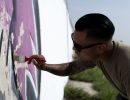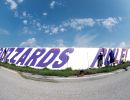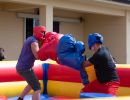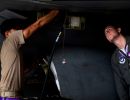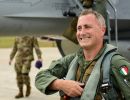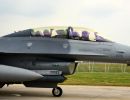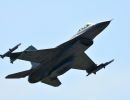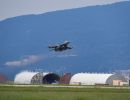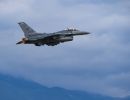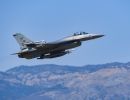He would later serve as a Stan Eval flight examiner with the 3575th Pilot Training Wing until December 1967. He was then was assigned to the 4510th Combat Crew Training Wing, Luke Air Force Base Arizona in January 1968 entering the Combat Crew Training program where he learned how to fly the F-100D Super Saber. After a six-month stint in the CCTS he was transferred to the 3rd TFW, 510th Tactical Fighter Squadron Bien Hoa Air Base, South Vietnam, June 1968. As a “Buzzard of Bien Hoa” he flew ground support and strike missions with the Buzzards until December 1968 and his nickname/call sign was Buzzard. On Sept. 12, 1968 while on alert duty the bell rang and two jets were scrambled in a matter of minutes to provide close air support; Capt. Fogleman took off flying F-100D S/N 56-3245. Flying low inbound to the target, he was hit various times by intense ground fire in the I Corps area 200 miles (320 km) south of Bien Hoa. He had no other alternative but to eject over an enemy stronghold deep in the U Minh Forest. After landing he quickly hid his parachute and began his escape and evasion plan, concealing himself in the thick forest vegetation. After a short period of time, he slowly made his way to a nearby canal surrounding a rice paddy, where he submerged himself up to his neck, undetected by the enemy who were searching for him and came within 20 yards of him. After spending a couple of hours on the ground he was picked up by an AH-1G Cobra helicopter in the vicinity of the crash site and rode out clinging to the chopper’s open ammo bay door for 20 miles until reaching the safety of a Special Forces camp. After being treated at an intermediate location hospital he was returned to Bien Hoa. The next day he was up in the air again flying a combat mission. Fogleman became the only Super Sabre pilot ever rescued by riding out on the outside of a Cobra helicopter. In December 1968, Fogleman volunteered to become part of a select group of pilots flying “Operation Commando Saber”, Fast Forward Air Controller missions over South Vietnam and Laos. Fogelman was known as Misty 86. As a fast forward air controller, flying under the most hazardous conditions, the Mistys operated in areas too well defended to allow the survival of slower FACs (O-1, 0-2 and OV-10). They operated under heavy fire from anti-aircraft artillery and surface to air missiles, to spot enemy troop and supply movements. They relayed this vital information to the intelligence community and controlled strikes of fighter aircraft assigned to destroy the targets. The typical Misty tour committed pilots to serving for either 120 days or 75 FAC sorties, whichever came first. Their standard operating profile of 450 KIAS at 4,500 feet altitude allowed them to survive. As a Fast FAC, the Mistys were one of the most important links in the out-country air control system; they served as a hub for the strike effort. They were in radio contact not just with the strike aircraft; but also talked to the Airborne Command and Control Center coordinating airstrike availability, to long range ground forces. Their expertise as air strike controllers made them an intelligence source, munitions experts, communication specialists, and above all, the on-scene commander of the strike forces at the start of any subsequent combat search and rescue when necessary. Of the 155 pilots assigned to Misty throughout the life of the program, forty-four, or 28%, were shot down while at Misty or before and after leaving the program. On 13 March 1969, Fogleman distinguished himself flying operations against an opposing armed force over Southeast Asia. Flying his Misty FAC F-100F, he conducted attacks against a major infiltration route. Captain Fogleman repeatedly flew through intense barrages of hostile flak to pinpoint targets for attacking fighters. His aggressiveness and courage in the face of marginal weather, mountainous terrain, darkness, and intense hostile fire were instrumental in the successful destruction of hostile antiaircraft artillery sites. For his skill and airmanship he was awarded the Silver Star for this combat mission. He went on to fly a total of 80 Misty FAC missions by April of 1969. Due to a shortage of experienced pilots, he returned to Bien Hoa Air Base and volunteered to extend his tour flying combat missions with the “Buzzards of Bien Hoa” until September 1969. After completing his tour he had flown 240 combat missions over South Vietnam and Laos. He returned to the States and attended graduate school at Duke University earning a Master’s Degree in Military History and Political Science and then became a history instructor at the Air Force Academy; as the war in Southeast Asia continued Fogleman volunteered to curtail his Academy assignment and return to the fighter world. In 1972, he was assigned to the 35th TFW, George AFB California for combat crew training and began flight training in the F-4 Phantom enroute to Southeast Asia. In April 1973 he was assigned to the 432nd Tactical Reconnaissance Wing Udorn Royal Thai Air Force Base, 4th Tactical Fighter Squadron as an F-4D/E aircraft commander. He flew his first combat mission in the F-4 with just 32 hours in the aircraft and when he reached 75 hours on the F-4 he was upgraded to instructor pilot and assigned to the 421st Tactical Fighter Squadron. Fogleman flew an additional 75 combat missions and at the same time, commanded the Laredo “Highway Patrol” Fast FAC program. In total during his tours of duty in Southeast Asia Fogleman flew 315 combat missions totaling 806 combat flying hours. He never had a tour in the Pentagon until he was a Colonel. He commanded at every level from Wing (56TFW), Air Division (836AD), Numbered Air Force (7AF), MAJOCOM (AMC) and Unified Command (USTRANSCOM) before becoming the 15th Chief of Staff of the USAF in October 1994. After 34 years of service to his country he retired from the Air Force 1 September 1997. He achieved over 7,800 flight hours, flying over 60 types of aircraft
Tuesday, 27 September 2022 14:37
Gen Ronald Fogleman - Bien Hoa Buzzard and CSAF Featured
Written by Paul "Rudy" PerronRonald R. Fogleman: He was born on January 27, 1942, in Lewistown, Pennsylvania. He graduated from Juniata Joint High School, Mifflintown, Pennsylvania, in 1959. Four years later he graduated with a Bachelor of Science Degree from the U.S. Air Force Academy, earning his commission as a Second Lieutenant. In June of 1963 he began pilot training at Vance Air Force Base, Oklahoma. He completed pilot training, receiving his Silver Wings in September 1964. Fogleman stayed on at Vance and was assigned to the 3575th Pilot Training Squadron for three more years as a First Assignment Instructor Pilot teaching student pilots to fly the T-37 Tweet.
Published in
Bien Hoa
Login to post comments



























